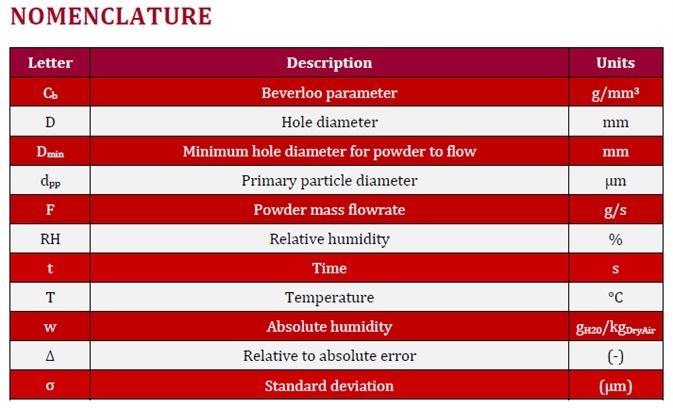
Fine powders and granular materials are used across a broad spectrum of industrial applications. To optimize and control processing methods, these materials have to be characterized with great accuracy.
The characterization methods are either related to the properties of the grains (granulometry, chemical composition, morphology), or to the behavior of the bulk powder (density, flowability, electrostatic properties, blend stability).
However, where the physical behavior of bulk powders are concerned, a high quantity of the methods used in R&D or quality control laboratories are based on old measurement techniques.
Over the past decade, some of these techniques have been updated to meet the present requirements of R&D laboratories and production departments.
In particular, rigorous initialization methods have been developed to obtain reproducible and interpretable results as well as the automatization of measurement processes.
Furthermore, implementing new image analysis techniques enhances the precision of the measurement.
A wide range of measurement techniques have been developed to cover all the required needs of industries processing powders and granular materials. However, in this article, the be focus will be on the GranuFlow instrument.
GranuFlow
In comparison with the antiquated Hall Flow Meter (ASTM B213, ISO4490) and the “Flow Through An Orifice” method described in the Pharmacopea (USP1174), the GranuFlow is a much anticipated and improved laboratory silo.
The GranuFlow is a relatively straightforward powder flowability measurement device made up of a silo with a variety of apertures associated with a dedicated electronic balance necessary to accurately measure the flowrate. This flowrate is automatically computed from the slope of the mass temporal evolution measured with the balance.
The aperture size can be modified rapidly and easily with an original rotating system.
The result analysis and measurements are software assisted.
The flowrate is subsequently measured for a set of aperture sizes to obtain an accurate flow curve.
Finally, the whole flow curve is then fitted with the familiar Beverloo theoretical model to acquire a flowability index (Cb, related to the powder flowability) and the minimum aperture size to obtain a flow (Dmin) (for theoretical background, user can refer to Appendix 1).
The whole measurement is performed with speed, ease, and precision.
In this study, we utilized a complete set of hole diameters: 4, 6, 8, 10, 12, 14 and 16 mm.
The main objective of this article is to provide the Pharmaceutical field with information regarding lactose analysis.
Lactose Analysis
1. Material
Meggle Pharma provided the powders used throughout the course of this application.
All samples are made up of lactose. They are named, by the manufacturer, Tablettose 70, Tablettose 80, Flowlac 90 and Flowlac 100. According to supplier’s data, the physico-chemical properties of these powders is clarified using the following table:

SEM pictures have been taken in order to have the information of the particle size distribution and particles shape made visibly available:
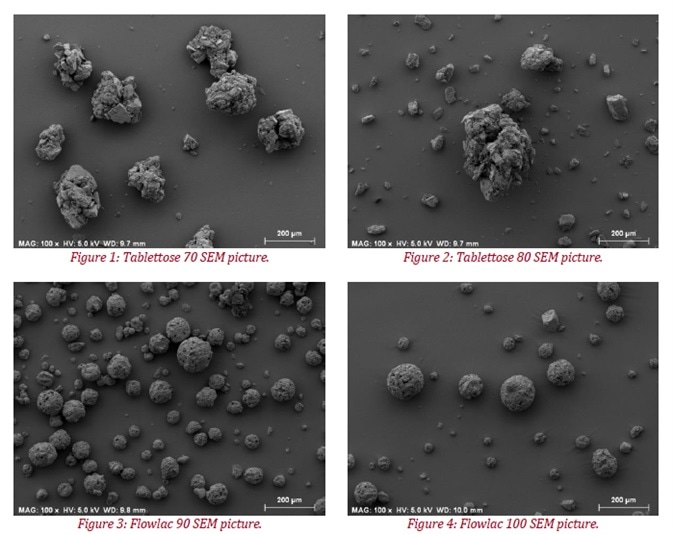
The initial observation concerns the shape of the particles; while the Tablettose samples are of an irregular formation, all of the Flowlac samples are spherical in their shape.
In addition, with the help of ImageJ Software, the granulometric analysis of the four samples has been performed (dpp is the mean primary particle diameter and σ the standard deviation):

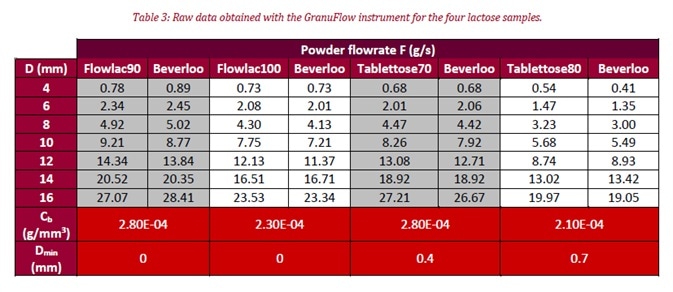
2. GranuFlow Analysis
The GranuFlow analysis was carried out at 26°C and 40.0% RH (w = 8.5gH20/kgDryAir).
The Mass Flowrate was examined across different hole sizes (from 4 mm to 16 mm).
F is the powder flowrate (in g/s) and Cb the Beverloo parameter (in g/mm3).
Dmin is the minimum aperture size to obtain a flow:


These results are particularly interesting, especially concerning the ‘look’ of Hausner’s ratio (cf. Table 1), we can see that the classical tap density test (“Densitap”) is unable to differentiate between one sample to another (despite the high heterogeneity in terms of samples physico-chemical composition).
However, the GranuFlow permits the user to make powder classification with great accuracy (with the help of Cb and Dmin parameters). Although, Flowlac 90 and Tablettose70 have the same Cb parameter, Dmin information enables the clarification that Flowlac90 has the optimal flowability from all samples and its followed by Tablettose70. Flowlac100 comes in third position, while Tablettose80 has the lowest flowability. To prove these assumptions the following figure demonstrates the mass flowrate according to hole diameter:
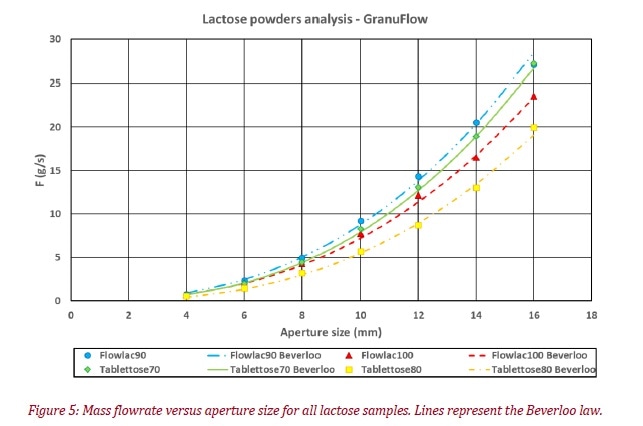
This graph illustrates the good correlation between experimental data and modeled values (with Beverloo law). This fact is of significant importance, because with the Beverloo model, the user can make data interpolation, and thus, can predict the mass flowrate for different hole sizes.
Conclusions
The GranuFlow enables plotting of the full mass flowrate curve.
The GranuFlow provides information about the Beverloo law (i.e powder flowability and minimum diameter for the powder to flow in silo configuration).
The GranuFlow allows for the classification of powders in terms of flowability, even if the classical tap density test is unable to see the Hausner ratio difference.
Bibliography
- Cascade of granular flows for characterizing segregation, G. Lumay, F. Boschin, R. Cloots, N. Vandewalle, Powder Technology 234, 32-36 (2013).
- Combined effect of moisture and electrostatic charges on powder flow, A. Rescaglio, J. Schockmel, N. Vandewalle and G. Lumay, EPJ Web of Conferences 140, 13009 (2017).
- Compaction dynamics of a magnetized powder, G. Lumay, S. Dorbolo and N. Vandewalle, Physical Review E 80, 041302 (2009).
- Compaction of anisotropic granular materials: Experiments and simulations, G. Lumay and N. Vandewalle, Physical Review E 70, 051314 (2004).
- Compaction Dynamics ofWet Granular Assemblies, J. E. Fiscina, G. Lumay, F. Ludewig and N. Vandewalle, Physical Review Letters 105, 048001 (2010).
- Effect of an electric field on an intermittent granular flow, E. Mersch, G. Lumay, F. Boschini, and N. Vandewalle, Physical Review E 81, 041309 (2010).
- Effect of relative air humidity on the flowability of lactose powders, G. Lumay, K. Traina, F. Boschini, V. Delaval, A. Rescaglio, R. Cloots and N. Vandewalle, Journal of Drug Delivery Science and Technology 35, 207-212 (2016).
- Experimental Study of Granular Compaction Dynamics at Different Scales: Grain Mobility, Hexagonal Domains, and Packing Fraction, G. Lumay and N. Vandewalle, Physical Review Letters 95, 028002 (2005).
- Flow abilities of powders and granular materials evidenced from dynamical tap density measurement, K. Traina, R. Cloots, S. Bontempi, G. Lumay, N. Vandewalle and F. Boschini, Powder Technology, 235, 842-852 (2013).
- Flow of magnetized grains in a rotating drum, G. Lumay and N. Vandewalle, Physical Review E 82, 040301(R) (2010).
- How tribo-electric charges modify powder flowability, A. Rescaglio, J. Schockmel, F. Francqui, N. Vandewalle, and G. Lumay, Annual Transactions of The Nordic Rheology Society 25, 17-21 (2016).
- Influence of cohesives forces on the macroscopic properties of granular assemblies, G. Lumay, J. Fiscina, F. Ludewig and N. Vandewalle, AIP Conference Proceedings 1542, 995 (2013).
- Linking compaction dynamics to the flow properties of powders, G. Lumay, N. Vandewalle, C. Bodson, L. Delattre and O. Gerasimov, Applied Physics Letters 89, 093505 (2006).
- Linking flowability and granulometry of lactose powders, F. Boschini, V. Delaval, K. Traina, N. Vandewalle, and G. Lumay, International Journal of Pharmaceutics 494, 312–320 (2015).
- Measuring the flowing properties of powders and grains, G. Lumay, F. Boschini, K. Traina, S. Bontempi, J.-C. Remy, R. Cloots, and N. Vandewall, Powder Technology 224, 19-27 (2012).
- Motion of carbon nanotubes in a rotating drum: The dynamic angle of repose and a bed behavior diagram, S. L. Pirard, G. Lumay, N. Vandewalle, J-P. Pirard, Chemical Engineering Journal 146, 143-147 (2009).
- Mullite coatings on ceramic substrates: Stabilisation of Al2O3–SiO2 suspensions for spray drying of composite granules suitable for reactive plasma spraying, A. Schrijnemakers, S. André, G. Lumay, N. Vandewalle, F. Boschini, R. Cloots and B. Vertruyen, Journal of the European Ceramic Society 29, 2169–2175 (2009).
- Rheological behavior of β-Ti and NiTi powders produced by atomization
- for SLM production of open porous orthopedic implants, G. Yablokova, M. Speirs, J. Van Humbeeck, J.-P. Kruth, J. Schrooten, R. Cloots, F. Boschini, G. Lumay, J. Luyten, Powder Technology 283, 199–209 (2015).
- The influence of grain shape, friction and cohesion on granular compaction dynamics, N. Vandewalle, G. Lumay, O. Gerasimov and F. Ludewig, The European Physical Journal E (2007).
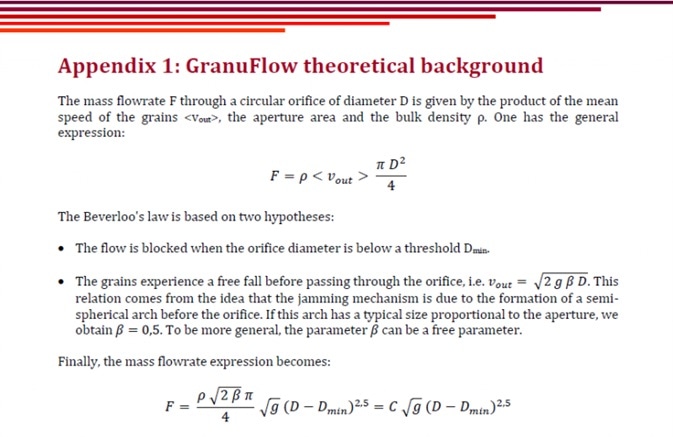
About Granutools
GranuTools, is a company that improves powder understanding by delivering leading edge physical characterization tools.
“All we do is powder flow characterization”
A Set of Complementary Tools
Combining decades of experience in scientific instrumentation with fundamental research on powders characterization, we offer a unique set of complementary instruments for granular materials characterization.
Named after their purpose, our instruments are tools to understand macroscopic behavior of powders.
GranuFlow for flow, GranuHeap for static cohesion, GranuDrum for dynamic cohesion, GranuPack for tapped density and GranuCharge for triboelectric charge measurements are designed with the following in mind:
- Precise & Repeatable
- Automatic
- No Operator Dependency
- Robust & Easy to Use
- Clear Interpretation